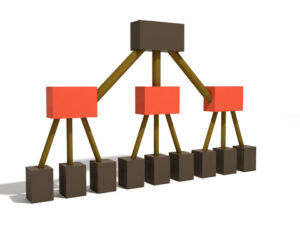I’m a coffee snob. I have a Gaggia, which I polish regularly. I’m a coffee machine snob. I’ve had a problem. The machine was spitting out coffee  grinds from the sides of the espresso holder. I was getting cups full of grit, and as a consequence, I was grumpy in the mornings.
grinds from the sides of the espresso holder. I was getting cups full of grit, and as a consequence, I was grumpy in the mornings.
So I tried a number of solutions. I tried washing out the espresso holder regularly. I tried different grinds of coffee, but only ended up with weaker cups. I tried different types of coffee, from Monsoon Malabar to Ecuadorian, but I always ended up with a poor end product.
Then I changed the little filter in the middle. I cleaned it more often, I ran descaler through it every month, and I looked after it. The result? Back to good coffee. I’d considered everything else – the inputs and the outputs, but not the little filter which had become clogged-up and worn-out.
Our line managers are our little filters. We’ve let them get clogged-up and worn out over the years. A study in the Harvard Business Review showed that businesses were failing in their change initiatives due to those little filters within our organizations – the middle managers. Looking at those who have succeeded in transformation, the “most important determinant of success was the role of MLMs (middle managers)”:
“MLMs served as levers of change, influencing those above and below them in the corporate hierarchy.”
Just like the Gaggia, our organizations are full of components – Benham Tabrizi calls them “moving parts”, and I especially like the claim that 60% of middle managers devote their time to “corporate survival”. In many organizations, middle managers focus on pleasing people, and put off making decisions for fear of failure. They can clog up the system, just as they have the potential to act as the most significant players in transformation.
Melissa Fairman at HR Remix says, “if you want successful change, it has to come from the top, the bottom and the middle”, and she’s spot on (as always). How can anyone expect a business to change if it’s led from the top and the bottom?
If middle managers aren’t aligned with what the business wants to do, if they’re not involved or held accountable, then what chance does the transformation have?
At a more granular level, imagine that you’re rolling out an employee assistance program. It’s part of your strategy to improve productivity and retain your people, but you haven’t bothered to inform line managers a) why you’re doing this and b) what the benefits are (point 8).
So what’s the point in doing it in the first place?
Those line/middle managers are the people who have constant interaction with your people – they’re on the front line every day, taking people to one side for informal chats, eating with their teams at lunchtime, going out on team-building exercises. So let them lead your productivity/retention strategy for you. They’re those “moving parts”, the “levers” who influence those below and above them within the business.
As businesses have grown, the potential of middle managers appears to have been forgotten. If they’re working to survive, turn that round – hold them accountable for the right things. If, as HBR says, they’re afraid of making decisions, taking risks, give them the tools and the training to make those decisions and the direction to take the right risks. Give them the background to your initiatives, and give them the confidence to take those initiatives out to the business and make them work.
Give those little filters a bit of love, eh.
Latest posts by Gareth Cartman (see all)
- Retention: Be the Best Stepping Stone You Can Be - October 2, 2022
- Stuck in the Middle with You: Why Middle Managers Matter - July 26, 2022
- Can Big Data save HR? - March 5, 2014












